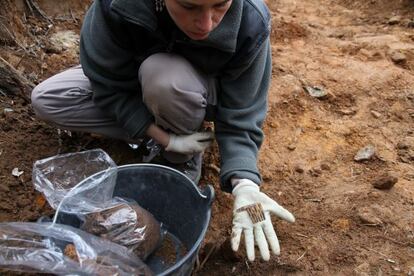Forensic students flock to Falangist massacre site to gain field experience
Villagers knew all along that Civil War victims were buried among houses

The exhumation of two Civil War graves that began on Monday in Espinosa de los Monteros, Burgos province, is being led by Francisco Etxeberria, a professor of forensics at the University of the Basque Country (UPV). Also participating is a group of 30 students from the UPV and the Autónoma University of Madrid, gaining their field experience in Criminal and Anthropological Physics.
The graves are the first to have been opened since a High Court panel ruling devolving responsibility to local courts for Civil War crimes. Thus far, no judicial visit to the site has been forthcoming.
Etxeberria has opened more than a hundred mass graves from the era but these are the first to be found in an urban area. Furthermore, the villagers have known for decades where they were. “To be present when a mass grave is exhumed is an experience that changes you forever,” says the scientist. “In this case, it had shown that the stories told, the memories that remain in the villages, are true.”
In the first grave, located between a front garden and a sidewalk in the village, lay 12 men executed by Falangist forces in 1936. In the second, just 200 meters away, are the remains of four women shot the following day. Tests are being carried out to discover if one of them is the aunt of Pedro Zorrilla, the president of the local victims’ relatives association.
“She was the wife of a prisoner who escaped from Burgos prison and who was assassinated in reprisal,” relate the students after hearing the testimony of family members. Zorrilla’s grandfather, Celestino, is also among the occupants of the male grave.
The area was urbanized some 45 years ago. Until then it was little more than a trail outside the village but it was known with such certainty that the victims of the Falangist massacre were buried there that every November 1, the Day of the Dead, families went there to lay flowers.
Tu suscripción se está usando en otro dispositivo
¿Quieres añadir otro usuario a tu suscripción?
Si continúas leyendo en este dispositivo, no se podrá leer en el otro.
FlechaTu suscripción se está usando en otro dispositivo y solo puedes acceder a EL PAÍS desde un dispositivo a la vez.
Si quieres compartir tu cuenta, cambia tu suscripción a la modalidad Premium, así podrás añadir otro usuario. Cada uno accederá con su propia cuenta de email, lo que os permitirá personalizar vuestra experiencia en EL PAÍS.
¿Tienes una suscripción de empresa? Accede aquí para contratar más cuentas.
En el caso de no saber quién está usando tu cuenta, te recomendamos cambiar tu contraseña aquí.
Si decides continuar compartiendo tu cuenta, este mensaje se mostrará en tu dispositivo y en el de la otra persona que está usando tu cuenta de forma indefinida, afectando a tu experiencia de lectura. Puedes consultar aquí los términos y condiciones de la suscripción digital.
Últimas noticias
From digital curfews to blocking apps: How technology experts protect their children online
Why the price of coffee has skyrocketed: from Brazilian plantations to specialty coffee houses
Confined to a Cuban hospital: When electricity is a matter of life or death
The complicated life of Francesca Albanese: A rising figure in Italy but barred from every bank by Trump’s sanctions
Most viewed
- Why we lost the habit of sleeping in two segments and how that changed our sense of time
- Trump’s obsession with putting his name on everything is unprecedented in the United States
- Pablo Escobar’s hippos: A serious environmental problem, 40 years on
- The Florida Keys tourist paradise is besieged by immigration agents: ‘We’ve never seen anything like this’
- Charles Dubouloz, mountaineering star, retires at 36 with a farewell tour inspired by Walter Bonatti








































